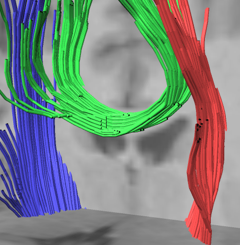BrainVoyager v23.0

Diffusion-Weighted Imaging Analysis
Background
Diffusion-Weighted Imaging (DWI) is rapidly increasing in populairty for studying white matter properties and structural connectivity in the living human brain. The technique measures the diffusion of water molecules by using diffusion-weighted MR pulse sequences. Acquired diffusion-weighted MRI data allow to quantify the mean diffusion within a voxel, which can be expressed as a 3-dimensional diffusion tensor (ellipsoid). If the water molecules within a voxel diffuse equally well in all directions, the estimated diffusion tensor will look like a sphere (isotropic diffusion). If diffusion is, however, restricted in some directions more than in others, the shape of the tensor will look like an american football (anisotropic diffusion). More formally, this can be expressed as a fractional anisotropy (FA) map. It has been shown in group studies that FA maps (or derived quantifications) may correlate with cognitive abilities, short-term plasticity and various diseases.
While FA maps quantify diffusion-weighted effects at the voxel level, diffusion tensor magnetic resonance imaging (DT-MRI) or Diffusion Tensor Imaging (DTI) relates diffusion-weighted measures across voxels in order to reconstruct structural connections in the brain. The main assumption of DTI is that diffusion is less restricted along fiber bundles than in other directions, and, thus, may be used to detect the direction of white matter fiber tracts running through a voxel. The axis of the diffusion ellipsoid with the largest elongation is interpreted as the main direction of diffusion within the voxel (eigenvector with the largest eigenvalue). In order to explicitly calculate and visualize presumed fiber bundles, the eigenvector orientations in neighboring voxels have to be connected in a proper way. This connecting process is called "fiber tracking" and may lead to beautiful visualizations. Note, however, that constructed fiber tracts may not always properly reflect the true pathways of axonal fiber bundles because the diffusion data of each voxel constitutes a discrete, noisy sample of the average diffusion within a quite large region of space (e.g. a cube of 2 x 2 x 2 mm). The results of DTI fiber tracking, thus, requires careful interpretation. Furthermore, the assumption that just one fiber bundle passes through a voxel has been relaxed in recent years and several improved models for tracking multiple fibers through a voxel have been proposed.
Overview of DWI Analysis Steps
BrainVoyager provides a comprehensive set of tools to analyze DWI data. As an active research area, it is expected that advanced new tools will become available with future program updates. In this User's Guide a general description of the available tools is provided. For a step-by-step instruction, consult the DTI Getting Started Guide "DTIGettingStartedGuide_v[version number].pdf" that is placed in the "GettingStartedGuides" folder within the "BrainVoyager" directory after program installation.
In BrainVoyager, DWI data is currently analyzed in three major stages as described below.
Single-run data in measurement space:
- Creating "DMR" projects using the Create Project Wizard
- Estimating diffusion tensors from DMR-DWI data
- Visualizing ADC and FA maps on measured slice planes
Single-run data in normalized 3D space:
- Alignment of DMR-DWI data with 3D VMR data set and transformation into ACPC or TAL space
- Estimating diffusion tensors from VMR-VDW data
- Visualizing ADC, FA and color direction maps
- Visualizing diffusion tensors
- Interactive fiber tracking
- Fiber tracking from regions-of-interest (VOIs)
Group comparison:
Copyright © 2023 Rainer Goebel. All rights reserved.